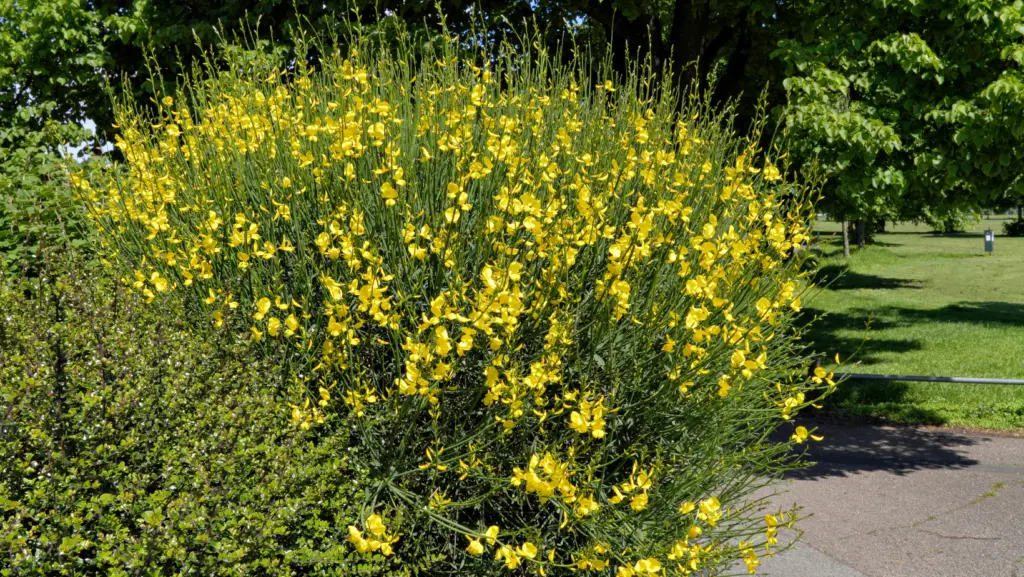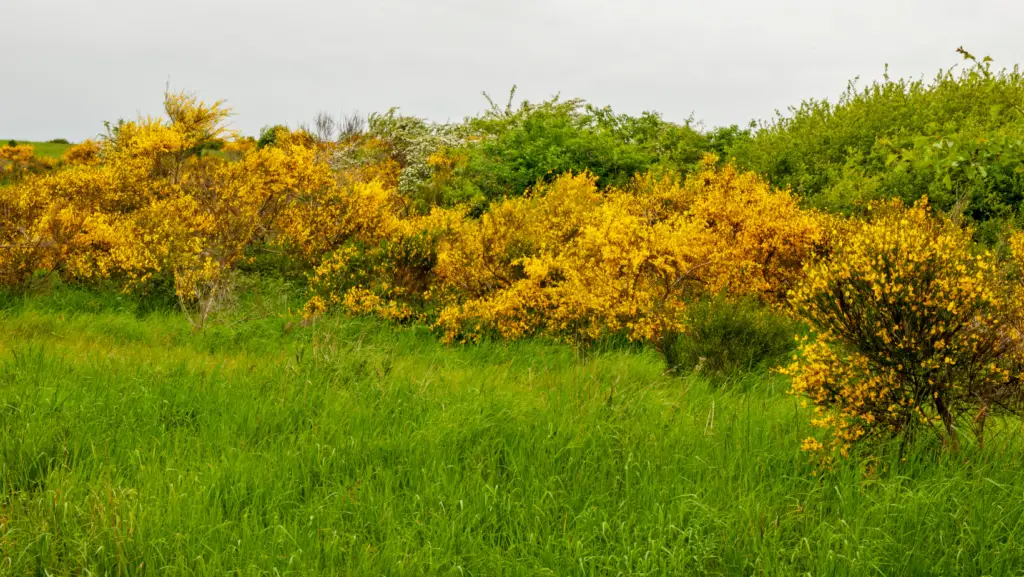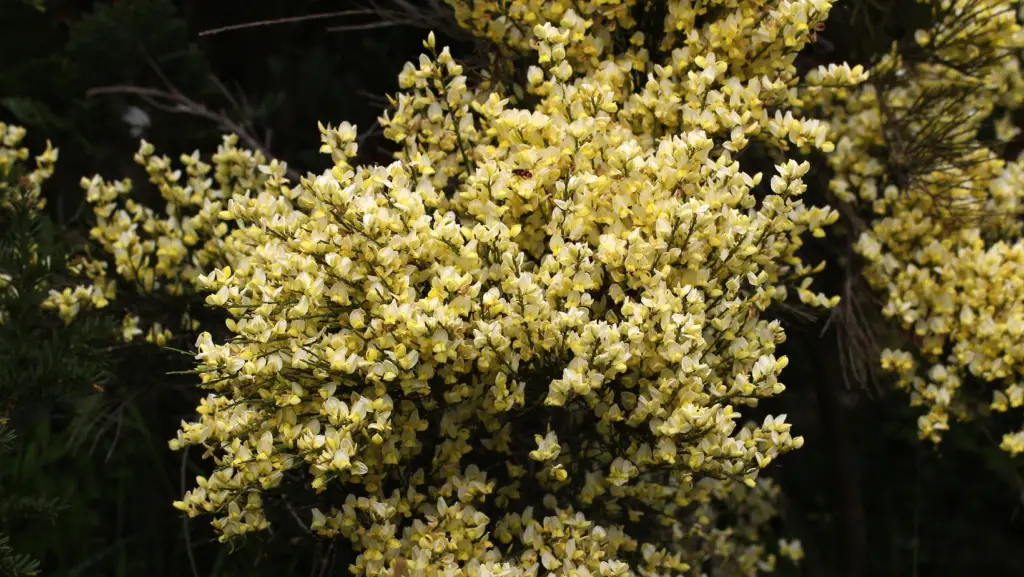
Under the common name of brooms are gathered several botanical genera of the same family. They have in common the shape of their flowers and the generosity of their bloom, but also limited needs.
In this article, I have gathered for you all the information about the broom plant, its main characteristics, and what you need to know to plant and grow it.
Characteristics of the broom plant
| Scientific name | Cytisus spp., Genista spp., Spartium junceum, Retama monosperma |
| Family | Fabaceae |
| Origin | Europe |
| Foliage | Deciduous |
| Flowering | April-June |
| Rusticity | -8°C to -20°C (–68°F) |
| Exposure | Sun |
| Soil | Indifferent, even dry |
| USDA Plant Hardiness Zone: | 5 to 9 |
These small shrubs, which rarely exceed 1 to 1.50 m, have small leaves attached to the stems that are practically unnoticeable. On the other hand, the fine, upright branches remain green all year long and give a rounded silhouette. But the decorative interest lies entirely in the small abundant flowers that cover the whole plant in late spring.
How to grow a broom shrub
All brooms can be grown in dark conditions. An ordinary soil is enough for them, and they adapt themselves even to ungrateful, stony, dry and poor grounds, provided that they are well drained. However, the Cytisus genus has a preference for acidic soils.
All of them need a clear and sunny situation.
Each year, after flowering, it is strongly advised to prune them, otherwise they grow on large wood that reacts badly to pruning, giving thin regrowth – with the exception of the spartier, which starts again with vigor even if it is re-cut on old wood. As a general rule, prune the vegetation back by half.

How to grow brooms in pots
Reserve it for species of the Cytisus genus and some Genista species. These brooms like to take their ease: repot in a pot of 30 to 40 cm in diameter, for a small plant bought in a 3 to 4 liter container.
Use a potting soil enriched with 1/5 of sand and put a drainage layer in the bottom of the pot.
Place in full sun and water moderately: once a week is usually enough. In summer, the contributions must be more frequent.
Where to plant a broom plant
Broom shrubs can be planted in a variety of locations to create different visual effects. They can be planted individually or in small groups, with different colors and variations of the shrub placed together to create a cohesive and visually pleasing display. They can be planted in pots, used as a low hedge, or incorporated into rock gardens for a natural and low-lying look.
This versatile shrub can be used in a variety of ways to enhance the landscape.
Our selection

Cytisus
Most of the interesting varieties are derived from Cytisus x praecox and C. x scoparius. All are equivalent; only the color of the flowers will make you choose one or the other.
– Cytisus x preacox: ‘Albus‘, pure white; ‘Allgold‘, yellow; ‘Hollandia‘, purple-red and white; ‘Zeelandia‘, creamy white and lilac.
– Cytisus × scoparius: ‘Andreanus‘, large yellow and red flowers with a rather spreading habit; ‘Booskop‘, ruby red with a rounded habit; ‘Burkwoodi‘, red and ochre; ‘La Coquette‘, pink and orange; ‘Palette‘, a mixture of red, orange and pink. ‘Luna‘, yellow with very large flowers, and ‘Lena‘, fiery red and yellow, very compact (50cm) are ideal for pot culture.
Also for pot and container culture or as ground cover, discover two curiosities: C. x kewensis and C. x kewensis “Niki”, 30 cm high with a diameter of almost 2m; the first one blooms creamy white in May, the second one more yellow.
For mild climates, plant C. racemosus, an interesting ground cover of 1m in height and diameter, with leaves composed of 3 leaflets that give it a false coronilla look. Bright golden yellow flowers; hardiness: – 8 to – 10°C.
Genista
– Genista hispanica, the true Spanish broom, has a regular and very compact dome-shaped habit of 50 cm height and l to 1,50 m diameter. From April, it is covered with yellow flowers.
– G. lydia, or Syrian broom, is also a perfect ground cover with its drooping branches, and its reduced dimensions, 50 cm high and 1 m in diameter; the flowering is bright yellow in May.
– The dyer’s broom, G. tinctoria, is mainly proposed under the variety ‘Royal Gold‘. It has a rounded habit, 50 to 60 cm high and 80 cm to 1 m wide; it blooms yellow in small clusters from June to August.
– The most cold-hardy is a selection from Canada, G. pilosa ‘Vancouver Gold‘, a prostrate and compact shrub, only a few centimeters thick and 50 cm in diameter.
– On the other hand, for the mild climates ‘G. Porlock‘ develops rapidly into a large shrub of 2 to 3 m. It is covered with yellow flowers in May.
Conclusion
Broom shrubs are an exceptional choice for any gardener looking to add a touch of natural beauty to their outdoor space. They are a versatile and low-maintenance option that will be sure to delight you. With so many different varieties available, there’s a broom shrub to match every aesthetic and personal taste.
We hope this article has sparked your interest in these wonderful plants, and we encourage you to give them a try and see the difference they can make in your garden.

Hi!
I am the guy behind Theyardable.com. I grew up on a homestead and I am here to share the knowledge I have and things I learn while living in the countryside.
